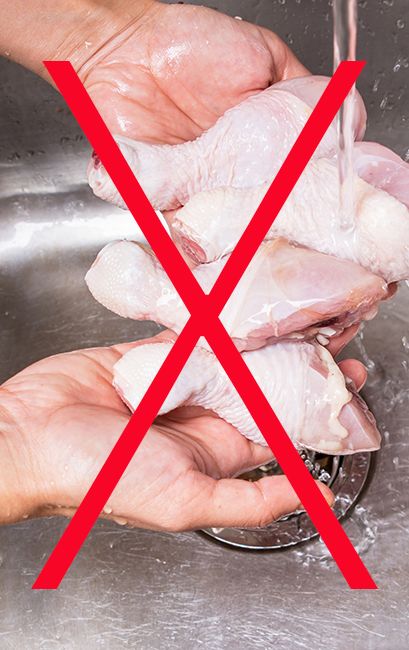When safely cooking food, one area of concern is handling raw meat. Raw meat is one of the biggest culprits of spreading foodborne illness. If not handled correctly, meat can carry a number of foodborne pathogens, such as Salmonella, E. coli, and Listeria. These dangerous diseases may cause abdominal pain, chills, fatigue, dizziness, fever, bloating, diarrhea, vomiting, and even death. Keep your family healthy by ensuring that you are handling your meat correctly.
Three reasons not to wash chicken before cooking
You may be wondering if you should be washing your chicken, or any raw meat, before preparing it. We learn the importance of washing other foods, such as vegetables, before consuming, but the common misconception that you should wash your meat before preparing it could be dangerous or even fatal.
Food safety experts have found that not only is it extremely ineffective, but it can cause diseases to spread further and contaminate other surfaces and foods. Many celebrity chefs, including Julia Child, have been guilty of this food safety violation. Here are three reasons why you should not wash your chicken before cooking.
Washing chicken does not remove pathogens
Foodborne pathogens cannot be killed by simply washing them off. Pathogens can only be killed by cooking meat to the proper temperature. These temperatures are set because they are the point at which the most common pathogens in that meat will be killed off. In chicken, for example, the most common pathogen is Salmonella.
Salmonella is killed at a temperature of 165° F (74° C) or above. To remove any excess liquid that was contained in the packaging, patting it with a dry paper towel is sufficient. Cooking meats is effective only if the meat has been thawed and handled properly. If chicken was left to thaw at room temperature to thaw, there is too many bacteria that even cooking it will not kill all the pathogens and could still make people sick.
Reference the table below to ensure that your meat has been cooked to the proper temperatures:
| Type of Meat | Temperature |
| Whole meats and seafood (beef, pork, veal, fish, shellfish) Roasts (Held at this for four minutes) |
145° F (63° C) |
| Ground meats and seafood (beef, pork, veal, fish, shellfish) | 155° F (68° C) |
| Poultry (including whole and ground) | 165° F (74° C) |
Marinate or brine meat for flavor, not as an attempt to kill bacteria. Marinating or brining meat does not reduce the number of pathogens contaminating the meat. Adding acid to such a marinade does not kill bacteria. If the meat has been brined or marinated before packaging, rinsing could make it less flavorful. Test the temperature by inserting a meat thermometer into the thickest part of the meat.
Washing any raw meat causes cross contamination
If you run your meat under water in the sink, the risk of disease spreading increases. The water you use to rinse the meat will then be contaminated by the pathogens. As the chicken is being rinsed, the water has a tendency to splash on other surfaces, such as a counter or utensils that may be near the sink, and contaminates those surfaces with dangerous pathogens. Instead of washing your chicken prior to cooking, you should choose your cooking method and directly prepare your chicken.
Be careful to avoid cross-contamination by using clean utensils and cutting boards and disinfect or sanitize the area you used to prepare the chicken. Also take note of what is around the chicken and be careful not to cross-contaminate those items.
Follow handling instructions provided on the package
The USDA requires that on all meat or egg products that are raw or only partially cooked, manufacturers must provide safe handling instructions for the consumer. Washing chicken is not included in these instructions. Following these instructions will ensure the safety of your food. As discussed above, cooking meat cannot effectively remove all bacteria if the product was handled improperly. If you have any questions about how to best handle the product, refer to these instructions.
Handling and preparing your meat and chicken properly can help you keep you and your family safe and healthy. Keep these tips in mind as you prepare your meals. For more information or other food safety tips, visit StateFoodSafety.com.
– Juli Shelley




